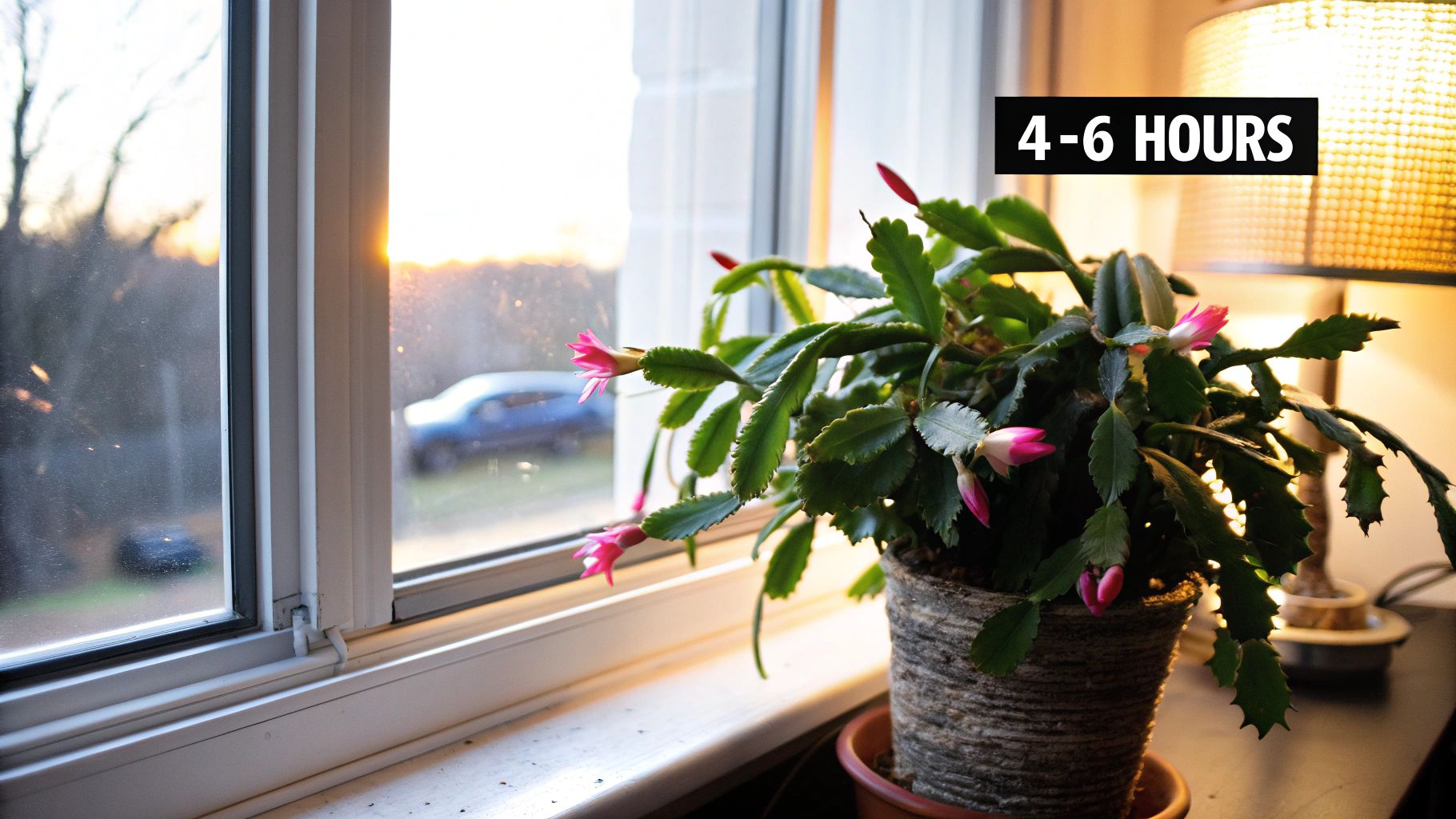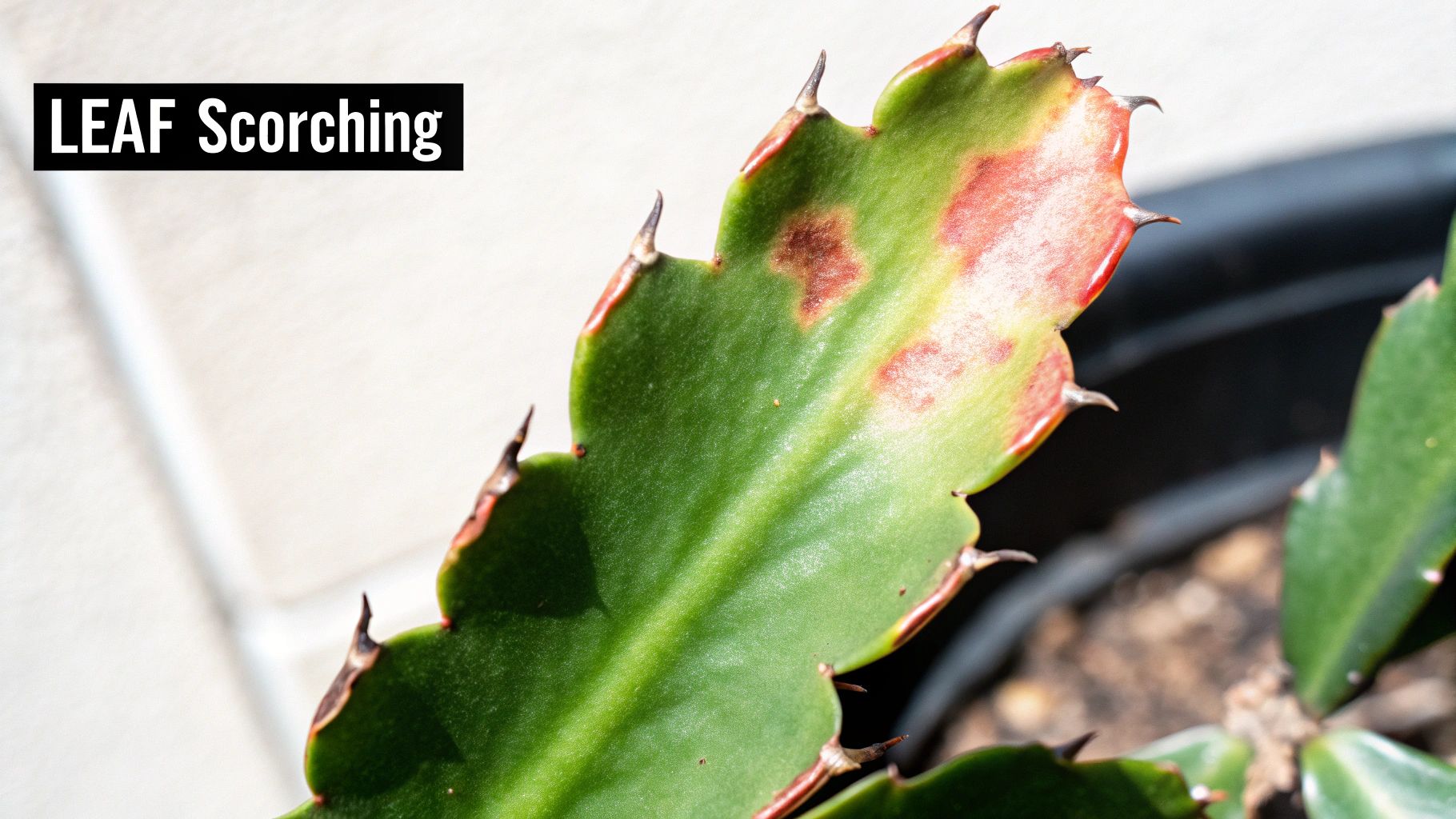If you've ever asked yourself, how much sunlight does a Christmas cactus need?, you're not alone. The answer is simpler than you might think: it's happiest with about 4-6 hours of bright, indirect sunlight each day. Gentle morning sun is perfect, but you'll want to avoid the harsh afternoon rays that can damage its delicate leaves.
Your Quick Guide to Christmas Cactus Sunlight

It’s a common mistake to think all cacti want to bake in the hot desert sun. The Christmas cactus, however, is a different kind of plant altogether.
Think of it less like a desert survivor and more like a tropical forest dweller. In its native Brazilian rainforests, it grows on tree branches, where it gets dappled sunlight filtered through the lush canopy above. This is exactly the kind of environment you want to mimic in your home.
Too much direct, harsh sunlight will actually scorch its leaves, causing them to turn a stressed-out red or yellow. Understanding this one crucial fact is the first step toward a thriving plant.
The Secret to Holiday Blooms: Balancing Light and Dark
With a Christmas cactus, it's not just about how much light it gets—it's also about the darkness. During its active growing season in spring and summer, those 4-6 hours of morning sun are essential.
But getting those gorgeous holiday blooms is a whole different ballgame. In the fall, the plant needs a special trigger: 13 or more hours of complete, uninterrupted darkness every single night. This is what tells the plant it's time to set buds. If you're struggling to get your cactus to flower, this light-dark cycle is almost always the key. You can dig deeper into the science behind Christmas cactus light requirements to really master the technique.
To make things easy, here’s a quick reference table to help you nail the perfect lighting conditions.
Christmas Cactus Sunlight At a Glance
| Light Condition | Ideal Duration | Best Time of Day | Placement Tip |
|---|---|---|---|
| Bright, Indirect Sun | 4-6 hours per day | Morning | Near an east-facing window or a few feet from a south-facing one. |
| Direct Sun | Avoid | None | Use sheer curtains to diffuse any harsh afternoon light. |
| Darkness (for blooms) | 13+ hours per night | Fall/Winter | Move to a dark room or cover the plant nightly for 6 weeks. |
Keep these guidelines in mind, and you'll be well on your way to a healthy plant that puts on a stunning floral display year after year.
Why Indirect Light Is the Secret to Success
To really get a handle on the right amount of sun for a Christmas cactus, you have to go back to its roots—literally. This isn't your typical desert cactus that thrives in the scorching sun. The Christmas cactus (Schlumbergera) is actually an epiphyte.
What does that mean? In its native home in the mountain forests of Brazil, it grows on tree branches, tucked away under the dense jungle canopy. It's a world away from the desert floor.
This one detail changes the entire game. It's not built to be blasted by direct, harsh sunlight. Instead, it’s used to the dappled, filtered light that makes its way through the leaves overhead. So, when you hear "bright, indirect light," just picture the soft glow on a forest floor. That's the sweet spot you're trying to create in your home.
Think of direct sun as the enemy. Putting a Christmas cactus in a south-facing window with no protection is like asking a shade-loving fern to survive in the Sahara. The intense rays are just too much, stressing the plant out and causing visible damage.
Spotting the Signs of Too Much Sun
Your Christmas cactus will tell you when the light is too intense. You just have to know what to look for.
The most common sign is the leaf segments turning a reddish or purple color. This is basically the plant's version of a sunburn; it's producing protective pigments to shield itself from the harsh rays. If it stays in that spot, you'll soon see scorched, yellow, and wilted leaves.
Not sure if your spot is too bright? Try the simple "shadow test."
Hold your hand up a few inches from the plant's leaves. If the shadow it casts is soft and has fuzzy edges, the light is perfect. If you see a sharp, well-defined shadow, the sun is too direct and you need to move the plant.
For those with skylights, which can sometimes create surprisingly intense hotspots of sun, understanding the importance of skylight diffusers can be a lifesaver. A good diffuser can turn harsh glare into the gentle, ambient light these plants crave. Your goal is simple: find a bright spot where the sun's rays don't hit the leaves directly for hours on end.
Finding the Perfect Spot in Your Home
Okay, let's move from theory to practice. Figuring out where to actually put your Christmas cactus is the single most important decision you'll make for its health. This isn't just a minor detail—it's the foundation for lush growth and those spectacular holiday blooms we're all after.
For most people, the sweet spot is near an east-facing window. Why? It gets that lovely, gentle morning sun that isn't strong enough to cause sunburn but provides plenty of energy to get the plant going for the day. By the time the intense afternoon sun rolls around, an east-facing spot is already in the shade.
Making Other Windows Work
But what if you don't have a perfect east-facing window? No problem at all, you've still got great options. Windows facing south or west get a lot more direct, intense sun, but we can easily work around that. The goal is simply to diffuse that powerful light.
- Sheer Curtains: Think of a thin, sheer curtain as a personal sunblock for your plant. It filters out the harsh rays, creating the soft, dappled light that Christmas cacti love.
- Strategic Distance: Don't feel obligated to put your plant right on the windowsill. Simply moving it back a few feet from a south- or west-facing window can make a world of difference, dramatically cutting down the light intensity.
If you find that direct sun is still sneaking through and causing issues, you can find many expert-approved ways to block harsh sunlight from windows to help you create that ideal little micro-environment.
To help you choose the best spot, here’s a quick breakdown of what to expect from each window direction.
Comparing Window Placements for Your Christmas Cactus
| Window Direction | Light Type | Pros | Cons / Precautions |
|---|---|---|---|
| East | Gentle Morning Sun | Ideal spot. Bright but not harsh, perfect for fueling growth without risk of sunburn. | None, this is generally the safest and best option. |
| South | Intense, All-Day Sun | Provides lots of light, which can be good in winter. | High risk of sunburn. Needs to be diffused with sheer curtains or placed far from the window. |
| West | Strong Afternoon Sun | Good light source if other options aren't available. | Can be too intense, especially in summer. The afternoon sun is hot and can scorch leaves. |
| North | Low, Indirect Light | The safest from direct sun. No risk of burning. | Often too little light. May result in leggy growth and a lack of blooms. Best for low-light plants. |
Ultimately, an east-facing window is your best bet, but with a little adjustment, a south or west window can work just fine. North-facing windows usually don't provide enough light to keep these plants truly happy.
The infographic below really brings this concept to life, showing how a simple buffer can turn a harsh spot into a perfect home for your plant.

This visual shows exactly how a curtain can create that safe, filtered environment. Getting the placement right is a common hurdle, and our guide on where to put a cactus in the house has even more ideas if you're feeling stuck.
Here's one last simple habit that makes a big difference: rotate your plant! Just give it a quarter turn every week or so. This little trick ensures all sides get their fair share of light, which prevents the plant from leaning and helps it grow into a full, beautifully balanced shape.
Adjusting Light to Trigger Holiday Blooms
Want to know the secret to getting your Christmas cactus to burst into flower right on time for the holidays? It’s not about giving it more light—it’s actually about giving it more darkness. This sounds a little backward, but it’s the single most important trick in the book.
Christmas cacti are what's known as "short-day plants." That's just a simple way of saying they take their flowering cues from the length of the night, not the day.
To get the blooming process started, your plant needs a dedicated period of long, completely uninterrupted nights. Think of it as putting your cactus on a very strict bedtime. Starting in the fall, usually around September or October, you need to ensure it gets at least 12 to 14 hours of total darkness every single night. This isn't a one-time thing; you have to keep it up for about six weeks for the plant to set its buds.
This crucial dark period mimics the changing seasons in its native Brazilian rainforests, telling the plant that winter is on its way and it's time to put on a show.
Creating the Perfect Dark Environment
Making sure your plant gets true, deep darkness can be tricky in a modern home. We're surrounded by ambient light from lamps, TVs, and even streetlights peeking through the windows. The problem is, even a little bit of light can interrupt the cycle and stop your plant from blooming.
Luckily, you have a couple of easy ways to enforce this "lights out" rule:
- Move It Nightly: The simplest method is to just move the plant every evening. Tuck it away in a dark closet, a spare bathroom with no windows, or even a basement. Just don't forget to bring it back out in the morning so it can get its usual dose of indirect light.
- Cover It Up: If hauling your plant around every day sounds like a chore, you can cover it instead. A cardboard box or a dark, breathable cloth draped over the plant works perfectly to block out any stray light.
The key here is consistency. If you skip a night or accidentally flip on a light in the middle of its dark period, you can break the cycle. That means you might have to start the six-week countdown all over again.
The Blooming Timeline
After you've diligently stuck to this light-dark schedule for about six weeks, you can finally relax the routine. By this point, you should be able to spot tiny flower buds starting to form at the very tips of the leaf segments.
Once you see those buds, just move the plant back to its favorite spot with bright, indirect light and go back to your normal watering and care. This carefully managed "rest" is the most reliable way to guarantee a stunning display of flowers, solving one of the biggest frustrations for Christmas cactus owners everywhere.
Taking Your Christmas Cactus Outdoors
Thinking of giving your Christmas cactus a little summer vacation? Moving it outside can really kickstart some impressive new growth, but you have to handle the transition with care. Just plopping it into direct sun is a recipe for disaster and will scorch its delicate, segmented leaves.
The trick is to find a spot that mimics its natural, filtered-light environment. Think about what it would be like under a forest canopy—that's the vibe you're going for. Look for a home on a covered porch, beneath the dappled shade of a big tree, or on a patio with an awning. These spots provide that bright, indirect light it loves without the burn.
How to Safely Move Your Cactus Outside
The absolute key to a successful move is acclimation. Plants, like people, get shocked by sudden changes. You need to introduce it to its new environment slowly over a week or two.
Here’s a simple process to follow:
- Start with Full Shade: For the first couple of days, find a spot that’s completely shaded. This lets your cactus get used to the outdoor temperatures and humidity without the stress of direct sun.
- Introduce Gentle Morning Sun: Next, move it to a location where it can catch about an hour of the soft morning sun. Slowly add a little more time in this gentle light over the next week.
- Settle it in its Summer Home: Once it’s adjusted, you can move it to its final spot for the season—that perfect location with bright, indirect light for most of the day.
This patient approach is the best way to prevent stress, leaf drop, and sunburn. For more tips that apply to other succulents, take a look at our guide on planting succulents outside.
Don’t forget this crucial step! Before you bring your plant back inside for the fall, give it a thorough pest check. Look under leaves, around the soil line, and in all the little nooks for hitchhikers like spider mites or mealybugs. You don’t want them invading your other houseplants.
Troubleshooting Common Light-Related Problems

Sooner or later, your Christmas cactus might start looking a little off. Don't panic! These plants are pretty good at telling you what's wrong. You just have to learn how to read the signs, especially when it comes to light.
One of the most obvious clues is a change in color. If you notice the leaf segments taking on a reddish, purplish, or yellowish tint, that’s a classic sign of too much direct sun. It’s basically a plant sunburn. The cactus is producing extra pigments to shield itself from the harsh rays. If you see this happening, it’s a clear signal to find a shadier spot. We dive deeper into this issue in our guide on why a cactus might be turning yellow.
On the flip side, what if your plant looks weak, spindly, and stretched out? That’s a cry for help, telling you it’s not getting enough sun. This "leggy" growth is the plant literally reaching for a better light source.
Correcting Common Light Issues
Once you've diagnosed the problem, the fix is usually pretty simple. It's all about tweaking the environment to give your plant what it needs.
- For Too Much Sun: Simply move your cactus further away from the window. Another great trick is to hang a sheer curtain to filter and soften that intense light. An east-facing window often provides that perfect balance of bright but gentle morning sun.
- For Too Little Sun: Find a brighter home for your plant. Moving it closer to that east-facing window is a good start. Just be careful not to make a drastic change from deep shade to intense sun, as that can shock the plant.
By keeping an eye on these simple cues, you can easily adjust its care and keep your Christmas cactus vibrant and healthy for many holiday seasons to come.
Your Top Questions About Christmas Cactus Light
We've gone over the ideal setup, but let's be honest, sometimes you run into very specific situations. I get these questions all the time, so let's clear up a few common head-scratchers.
Can a Christmas Cactus Really Survive in Low Light?
Technically, yes, it can survive for a while in a dim corner. But it definitely won't be happy. Think of it as the plant equivalent of just getting by.
You'll see it start to look weak and "leggy," meaning the stems get long and stretched out as they desperately search for more light. More importantly, you can pretty much forget about seeing any of those gorgeous holiday blooms. For a healthy, flowering plant, bright, indirect light isn’t just a suggestion—it's essential.
Do I Actually Need a Grow Light?
Most of the time, no. If you've got a decent window spot, especially one facing east, you're golden.
However, if your home is on the darker side or you live somewhere with gloomy winters, a simple full-spectrum LED grow light can be a game-changer. It’s a great way to give your cactus that extra boost it needs to stay energized and prep for blooming season.
Pro Tip: If you notice a reddish or purplish tint creeping into the leaves, that's your cactus waving a red flag. It’s a classic sign of stress, almost always from too much direct sun. Think of it as a plant sunburn. The fix is easy—just move it back to a spot with gentler, indirect light.




